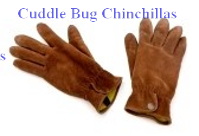Chinchillas are a variety of rodent. Rodents of all kinds chew, nibble and bite. All three are perfectly normal behaviors for a chinchilla. The differences are the manner and circumstances surrounding the incidence. Chewing, of course, is usually done while eating or using chew toys. Chinchillas do not sit and chew on people in the way they would their food or toys. This is due to the fact that they do not consider humans to be food.
Nibbling

A chinchilla grooming its cage mate

This chinchilla is grooming
his owners fingernails
If, at any time, a chinchilla nibbles hard enough to cause pain, immediately tap them lightly on the nose and say “no” in a firm but calm voice. Chinchillas do learn quickly and only a few instances are necessary to teach them how hard is too hard.
Biting
Biting is different from nibbling or grooming. It is either a defensive or aggressive act. A frightened or angry chinchilla will bite. This can happen when a chinchilla is new, pushed too far, not properly socialized, mistreated, or fighting with another chinchilla. A chinchilla bite can be quite severe and is very painful. As soon as possible, thoroughly clean the wound and apply an antibiotic ointment. If the bite does not stop bleeding, a trip to the doctor for stitches may be necessary.

A chinchilla bite
Chinchillas that are not properly socialized can become biters. When chinchillas are left for long periods without attention from humans, they can become aggressive and bite anyone who tries to handle them. Additionally, if a chinchilla is not used to children, they can become quite frightened by them. Children often are louder and move more suddenly than adults. This combination can be terrifying to an animal that is not accustomed to the presence of children.
Mistreated chinchillas often bite to avoid the mistreatment. Until they are used to their new surroundings and family, they will not understand that they are not going to get hurt again. These chinchillas usually take much longer to become tame (often months) than chinchillas that were not mistreated. Love, kindness, and patience are the keys with these poor animals.
The final reason a chinchilla may bite is if it already angry due to fighting with another chinchilla. Care must be taken when separating fighting chinchillas. Hands and fingers often get mistaken for the other chinchilla and will get bit. That being said, do not wait too long to separate fighting animals. Chinchillas are quite capable of inflicting serious injury to each other in just seconds, possibly resulting in the death of one or both animals.
How to Handle Biting
The best method to handle biting is to avoid the circumstances that cause it. When chinchillas are properly handled, tamed, and socialized, they do not bite unless provoked. Young chinchillas should be taught early how hard a nibble is acceptable by lightly tapping the nose and firmly saying “no”. Repeat this with any painful nibble until the chinchilla begins to use softer nibbles. Never use a raised voice or hit the chinchilla. This will cause an increase in biting and will make the chinchilla afraid of people.
If a chinchilla is a biter when purchased or develops into one later, a couple of methods do exist that will help stop the biting. Most bites occur when the owner is reaching for the chinchilla to pick it up. Never chase a chinchilla around its cage. This can cause panic and provoke a bite. Always reach in and scoop up the chinchilla in one quick motion. If the chinchilla bites, do not stop. Just continue to scoop up the chinchilla. If you stop or back off, you will teach the chinchilla that biting will get it what it wants. In this case, it will teach him that biting will make their owner go away. If the bite is bad, take the chinchilla with you to treat the wound or hand it toanother person. Do not yell at or strike the chinchilla. Stay calm. The same is true if the chinchilla bites while being held. In this case, gently tap their nose and firmly say “no”. Do not put the chinchilla down or back in its cage until it stops biting. If treated this way each time it bites, the chinchilla usually stops biting within a few days or weeks.

A pair of leather gloves can
prevent injury from a bite
A Special Case and Warning
Chinchillas that are fed treats through the cage bars will often bite whenever someone sticks their fingers in the cage. They are not being aggressive; they are just expecting a treat. To avoid this, never feed a chinchilla treats through the bars. Instead, open the cage and reach through the door to give the chinchilla its treat. This is especially important if small children are ever around the chinchilla since children will often stick their fingers through the cage bars to pet the chinchilla.



 Site Last Updated on December 31, 1969 05:00 pm
Site Last Updated on December 31, 1969 05:00 pm